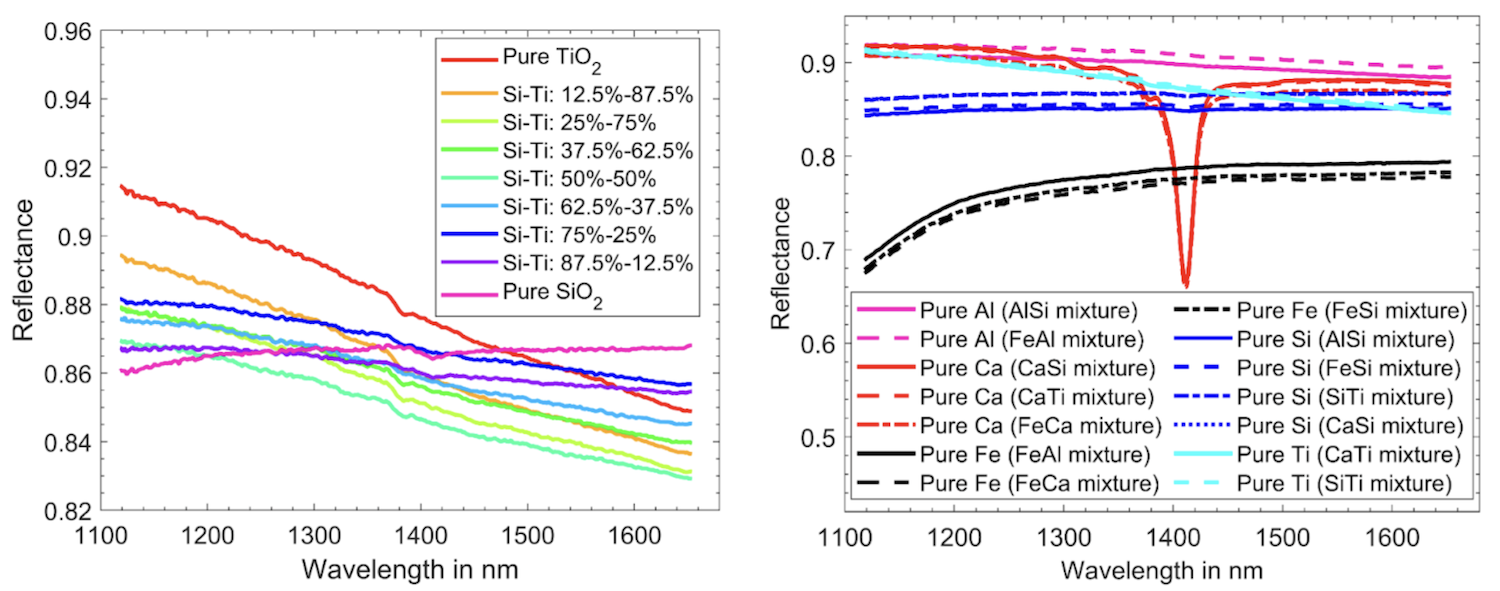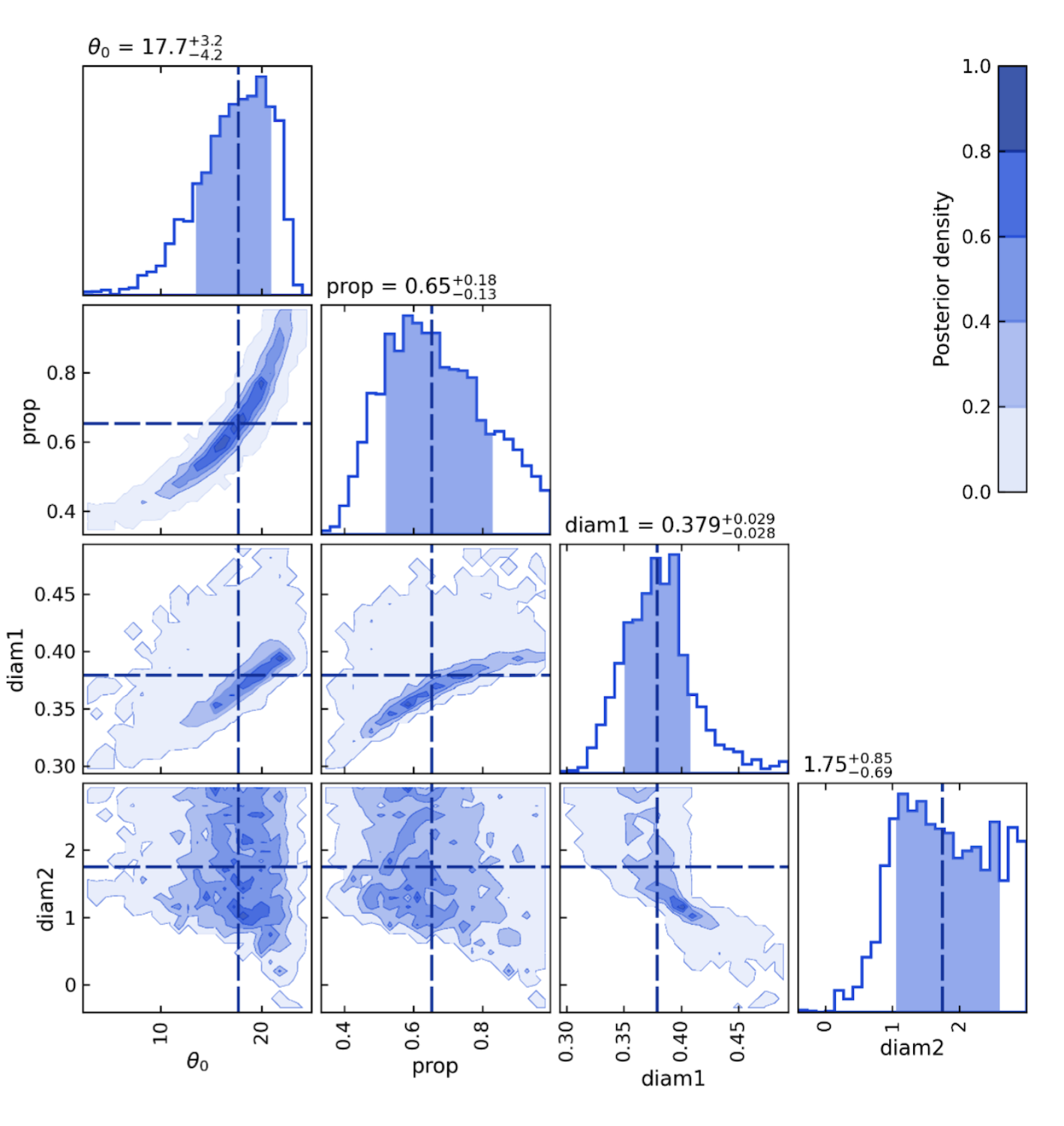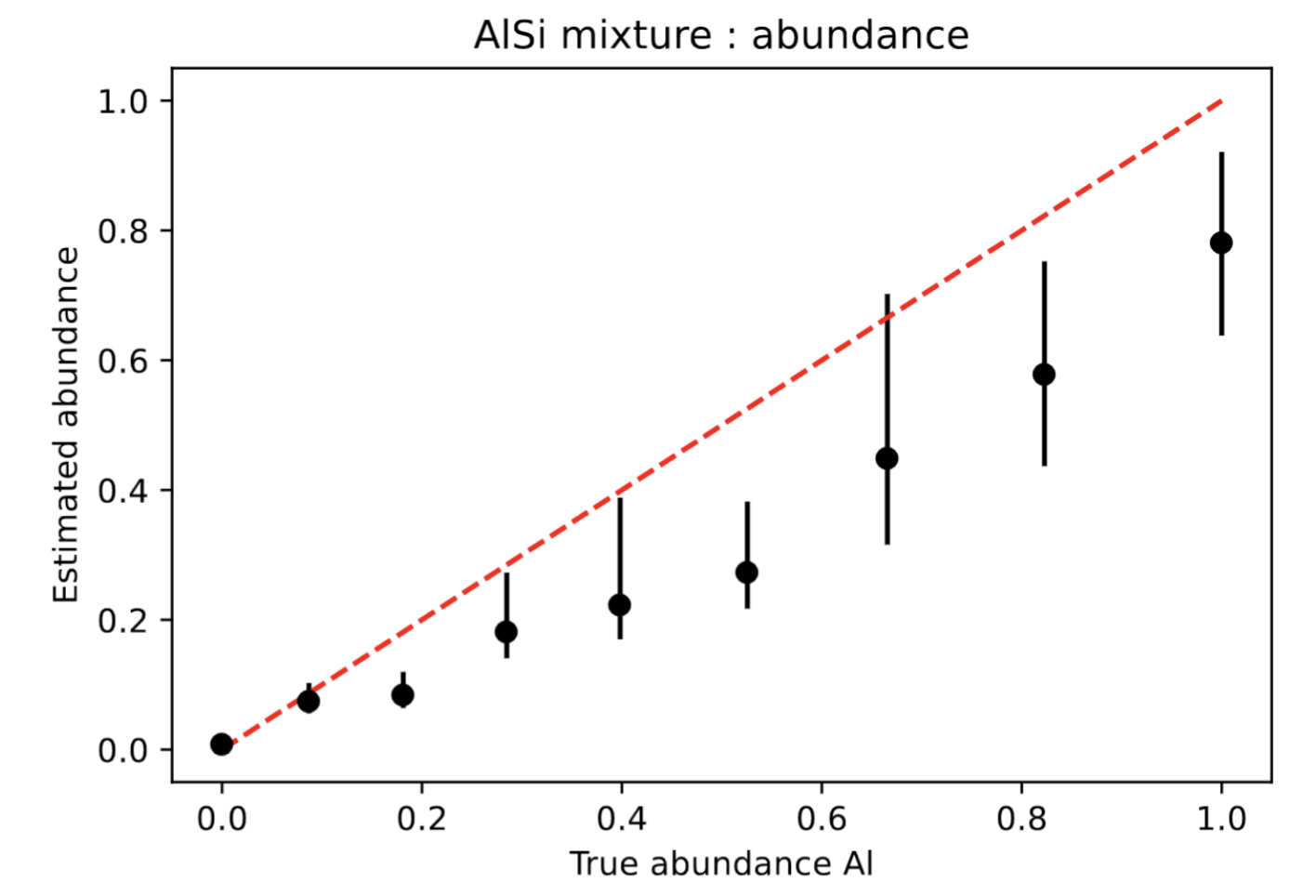Validation of abundance determination of granular mixture using radiative transfer and Bayesian MCMC
- 1Université Paris-Saclay, CNRS, GEOPS, 91405, Orsay, France
- 2Institut Universitaire de France, IUF, Paris, France
- 3Imec-Visionlab, Department of Physics, University of Antwerp
Introduction
The quantitative estimation of volumetric abundance of powder mixture is the basis of quantitative remote sensing analysis. Here we propose to analyze a unique laboratory measurements set, with precise composition, grain size and volumetric abundance.
We first propose a method to estimate the optical constant of materials, knowing the pure endmember spectra and their grain size. Then, we propose a method to transfer the measurement uncertainties to the volumetric abundance, based on the Bayesian approach and the full Hapke radiative transfer model. Using this approach, we are able to estimate grain size, volumetric abundance, and surface roughness.
The results show that this approach is able to well estimate the correct volumetric abundance with an uncertainty of 23% and grain size with a ratio uncertainty of 3.0, i.e. uncertainties in log10(grain size)=0.48. The numerical cost of the MCMC is quite large (a few minutes per spectra) but still reasonable to treat a hyperspectral image with the gain of robust handling of non-linearities and propagating the uncertainties.
Data
We used the laboratory data set containing 63 spectra, including 14 pure mineral powders and 49 binary mixtures of mineral powders (Koirala et al., 2021). These mixtures were created using 5 selected pure mineral powders: Aluminum oxide (Al2O3), Calcium oxide (CaO), Iron oxide (Fe2O33), Silicon dioxide (SiO2), and Titanium dioxide (TiO2). All mineral powders have a white color in the visible (except for Iron oxide which is red). Furthermore, they vary in densities and grain sizes. Although there are 10 possible combinations of these powders, due to experimental constraints the dataset contains exclusively seven binary mixture combinations of minerals namely: Al2O3-SiO2 (Al-Si), CaO-SiO2 (Ca-Si), CaO-TiO2 (Ca-Ti), Fe2O3-Al2O3 (Fe-Al), Fe2O3-CaO (Fe-Ca), Fe2O3 SiO2 (Fe-Si), and SiO2-TiO2 (Si-Ti). The provided dataset is particularly difficult to handle, without renormalization since several measurements of the same pure endmember are reproduced with a significant absolute level variability (see Figure 1).

Figure 1 : Spectra of binary granular material mixtures. (left) example of binary mixture Si-Ti (right) Several observation of the same endmembers.
Method
We used the semi-analytical reflectance model from (Hapke, 2012), which is a good compromise between physical realism and efficient computation time. In Andrieu et al., 2022, we demonstrated that the usual gradient-descent method is not helpful because the non-linearities are so strong that the results mainly depend on the initialization. So the analysis is done by a Monte Carlo Bayesian approach to propagate the uncertainties from the measurement in reflectance to the parameters (Cruz Mermy et al., 2023). This operation is sometimes called inversion or assimilation.
Results
Figure 2 presents a typical result. This particular one is for a CaSi mixture with XCa=57.0%. The best fit is extremely close to the real observation. In addition, due to the uncertainties on the reflectance spectra, a range of solutions is acceptable. Figure 3 shows the corresponding posterior PDF for the four parameters that are unknowns: roughness θ0, volumetric proportion of XCa, grains size log10(DCa) and log10(DSi). All marginal PDFs are well constrained with a bell shape, except the log10(DSi) which is less constrained. The bivariate PDF indicates the relationship between the parameters. For instance, roughness seems highly correlated with the XCa.
Figure 3 shows the estimation of the abundance for the Al-Si mixture case. It shows that the trend is well reproduced in all cases. The global RMS is 23.0% for proportions X and 48.9% for log10(D). When the grain size is known, the RMS for X reduces to 21.1%.

Figure 2 : Posterior PDF of the same case as Fig. 2 for the four unknown parameters: roughness θ0, volumetric proportion of XCa, grains size log10(DCa) and log10(DSi). The median values are indicated by a dashed line.

Figure 3 : True versus estimated volumetric abundance for all binary mixtures, estimating the four following parameters: roughness θ0, volumetric proportion X, grains sizes. The median and the 68.3% quantiles are plotted as the error bar.
Conclusion and perspective
We proposed a methodology to characterize powder samples from the shortwave infrared reflectance dataset (Schmidt et al., 2024). The methodology does not require the optical constant but only pure endmember spectra. In real remote sensing data, this is often not present in the scene. It may be possible to estimate endmembers by utilizing blind spectral unmixing methods such as the one presented in Ceamanos et al., 2011. Of course, if the optical constants are available, this first step can be bypassed.
Interestingly, the knowledge of the grain size does not help much to constraint the abundance due to the absolute level uncertainties due to absolute level uncertainties (see Fig. 1 right). This effect is difficult to handle in the lab, due to variability in roughness, compaction, illumination condition, calibration and should be even more difficult for real data.
Reference
Andrieu, F. Schmidt, G. Cruz-Mermy, I. Belgacem, and T. Cornet, Benchmarking Bayesian methods for spectroscopy,” in European Planetary Science Congress, Sep. 2022, pp. EPSC2022–502.
Bioucas-Dias, J.; Plaza, A.; Dobigeon, N.; Parente, M.; Du, Q.; Gader, P. & Chanussot, J. Hyperspectral Unmixing Overview: Geometrical, Statistical, and Sparse Regression-Based Approaches Selected Topics in Applied Earth Observations and Remote Sensing, IEEE Journal of, 2012, 5, 354-379,
Ceamanos, X.; Doute, S.; Luo, B.; Schmidt, F.; Jouannic, G. & Chanussot, J. Intercomparison and Validation of Techniques for Spectral Unmixing of Hyperspectral Images: A Planetary Case Study Geoscience and Remote Sensing, IEEE Transactions on, 2011, 49, 4341-4358, http://dx.doi.org/10.1109/TGRS.2011.2140377
Cruz Mermy, G.; Schmidt, F.; Andrieu, F.; Cornet, T.; Belgacem, I. & Altobelli, N. Selection of chemical species for Europa's surface using Galileo/NIMS Icarus, Elsevier BV, 2023, 115379, http://dx.doi.org/10.1016/j.icarus.2022.115379
Hapke, Theory of Reflectance and Emittance Spectroscopy, 2nd ed, Cambridge University Press, 2012.
Koirala, B.; Zahiri, Z.; Lamberti, A. & Scheunders, P. Robust Supervised Method for Nonlinear Spectral Unmixing Accounting for Endmember Variability IEEE Transactions on Geoscience and Remote Sensing, Institute of Electrical and Electronics Engineers (IEEE), 2021, 59, 7434-7448, http://dx.doi.org/10.1109/tgrs.2020.3031012
Schmidt, F.; Koirala, B., Andrieu, F., Determination of volumetric abundance of intimate mixture using Bayesian MCMC, 2024, under review in IEEE Sensor
How to cite: Schmidt, F., Koirala, B., and Andrieu, F.: Validation of abundance determination of granular mixture using radiative transfer and Bayesian MCMC, Europlanet Science Congress 2024, Berlin, Germany, 8–13 Sep 2024, EPSC2024-902, https://doi.org/10.5194/epsc2024-902, 2024.